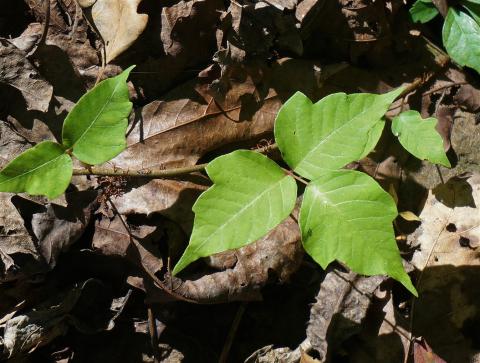What can I do to get rid of the poison ivy in my yard?

For those who are allergic, poison ivy can be one of the most troublesome nuisances in the landscape. Not only is it responsible for giving many people horribly itchy, blistery rashes, but it can also be very difficult to manage. Most non-chemical approaches require at least some contact with the plant and herbicides must often be applied more than once for total control.
Identification
Before you launch a poison ivy control effort, start by making sure you’ve correctly identified the plant. Many people know the adage “leaves of three, let it be”, but this phrase can be woefully misleading. There are a number of harmless three-leaved plants that look very similar to poison ivy, such as dewberry and black raspberry (if it has thorns, it’s safe it say it’s not poison ivy). Wild sarsaparilla and Virginia creeper are also frequently confused with poison ivy, especially early in the season.


Part of what makes poison ivy so difficult to identify are the wide variety of growth habits it displays depending on the environment it is growing in. It can climb upwards into trees as a vine with many hairy aerial rootlets, creep along the ground, or appear shrub-like.

It is easiest to recognize poison ivy by its leaves, which are always compound with three leaflets. A close inspection will reveal that the middle leaflet has a long stalk, while the adjacent two appear to be directly attached to the stem. The leaf edges are more variable. Some have large notches, others jagged teeth, and some have smooth edges.
Control
If you are planning to control a patch of poison ivy, you should dress for it. Try to cover as much of your skin as possible to avoid accidental contact with the plant. Wear long sleeves, long pants, closed toed shoes, tall socks and heavy-duty disposable gloves.
Individual plants can be hand-pulled with extreme care, or larger patches can be repeatedly mowed. Herbicide applications can also be effective and reduce the chance of getting a rash. Herbicides containing triclopyr or glyphosate should be applied when plants are actively growing in the late spring through the early fall. Be aware that a single application may not be enough to entirely eliminate an established population. Poison ivy is a tough perennial plant that often resprouts from its hardy root system. Repeated herbicide applications may be necessary to achieve complete eradication. Before applying any herbicide, make sure you fully read and follow the product label.
When working around poison ivy, it’s hard not to come in contact with it at some point. If you suspect you were exposed, you should wash your skin as soon as possible. Old-fashioned yellow laundry soap or rubbing alcohol will remove the oils and should stop the further spread of the rash. Make sure to also wash any clothing or equipment that may have touched the plant.
Even after you have controlled poison ivy, be very careful around it for some time. The oils can be present on the stems and roots for a year or more.
Got questions? The Ask UNH Extension Infoline offers practical help finding answers for your home, yard, and garden questions. Call toll free at 1-877-398-4769, Monday to Friday, 9 a.m. to 2 p.m., or e-mail us at answers@unh.edu.
Do you love learning about stuff like this?
SUBSCRIBE TO Granite State Gardening newsletter
Got questions? The UNH Extension Yard and Garden Infoline offers practical help finding answers for your yard and garden questions.
Call toll free at 1-877-398-4769, Monday to Friday, 9 a.m. to 2 p.m., or fill out webform.
